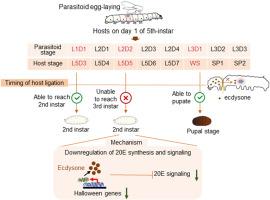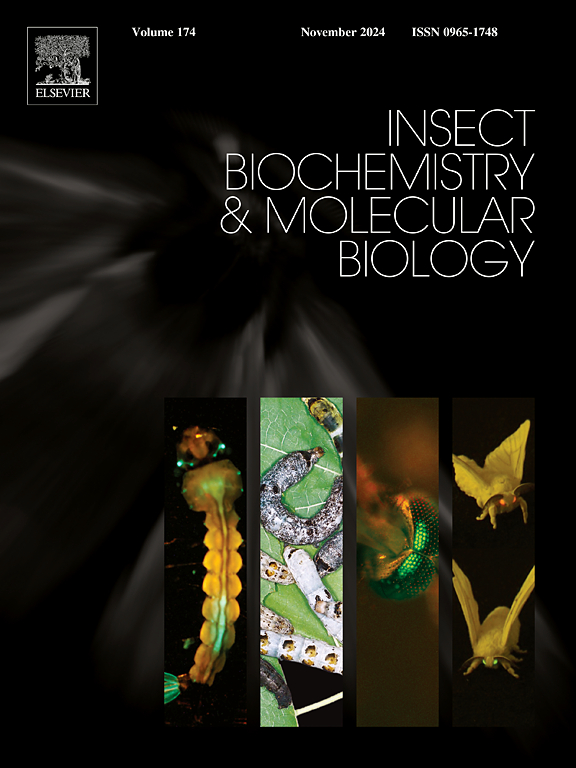寄生虫的幼虫发育取决于寄主的蜕皮激素。
IF 3.7
2区 农林科学
Q2 BIOCHEMISTRY & MOLECULAR BIOLOGY
引用次数: 0
摘要
寄生虫的发育通常表现出高度的灵活性,这取决于寄生时宿主的不同阶段,但对这种灵活性的内在机制却知之甚少。在这项研究中,我们评估了寄生于鳞翅目模式昆虫桑蚕(Bombyx mori,鳞翅目:Bombycidae)的寄生虫桑蚕(Exorista sorbillans,双翅目:Tachinidae)的幼虫发育时间。我们发现,寄生在晚发育家蚕上的山蚕蛾幼虫的发育时间明显短于寄生在早发育寄主上的幼虫。耐人寻味的是,当寄主体内的蜕皮激素滴度增加到较高水平时,寄生虫的第2-3龄蜕皮总是发生。此外,通过胸腹结扎寄主来抑制蜕皮激素向寄生虫腹部的释放,只能抑制山丁虫幼虫第2龄的生长和蜕皮,但对其化蛹没有影响。同时,结扎处理阻碍了寄生幼虫体内蜕皮激素的合成和 20-hydroxyecdysone (20 E) 信号的传递。此外,施用外源 20 E 可以通过刺激蜕皮激素的合成和信号传导,在很大程度上挽救寄生虫 2龄期生长和蜕皮的缺陷。我们的研究结果表明,寄生虫需要寄主的蜕皮激素来刺激 20 E 信号传导,进而促进第二龄幼虫的生长和蜕皮。这些发现将增进我们对寄生虫宿主利用策略的了解,并有助于开发用于生物防治的鞘翅目寄生虫体外饲养程序。本文章由计算机程序翻译,如有差异,请以英文原文为准。

Larval development of a parasitoid depends on host ecdysteroids
Parasitoids often exhibit high flexibility in their development depending on stages of their host at the parasitism, yet little is known about the mechanism underlying such flexibility. In the study, we evaluated the larval development time of the parasitoid Exorista sorbillans (Diptera: Tachinidae) on the lepidopteran model insect Bombyx mori (Lepidoptera: Bombycidae). We found that the development duration of E. sorbillans larvae parasitizing on the late-developmental silkworms was significantly shorter than that of the larvae parasitizing on the early-developmental hosts. Intriguingly, the 2nd-3rd instar molting of parasitoid always occurred when the ecdysteroid titers in the host were increased to higher levels. Furthermore, inhibiting the release of ecdysteroids to parasitic abdomen by thorax-abdomen ligation of the host only repressed the 2nd-instar growth and molting of E. sorbillans larvae, but had no effect on their pupation. Meanwhile, the ecdysone synthesis and 20-hydroxyecdysone (20 E) signaling in larval parasitoids were impeded after ligation treatment. Moreover, exogenous 20 E application could largely rescue the defect in 2nd instar growth and molting through stimulating ecdysone synthesis and signaling in E. sorbillans. Our results indicate that the parasitoid requires the host ecdysteroids to stimulate 20 E signaling and the subsequent 2nd-instar growth and molting. These findings will improve our understanding of the host utilization strategies of parasitoids, and contribute to the development of in vitro rearing procedures of tachinid parasitoids for biological control.
求助全文
通过发布文献求助,成功后即可免费获取论文全文。
去求助
来源期刊
CiteScore
7.40
自引率
5.30%
发文量
105
审稿时长
40 days
期刊介绍:
This international journal publishes original contributions and mini-reviews in the fields of insect biochemistry and insect molecular biology. Main areas of interest are neurochemistry, hormone and pheromone biochemistry, enzymes and metabolism, hormone action and gene regulation, gene characterization and structure, pharmacology, immunology and cell and tissue culture. Papers on the biochemistry and molecular biology of other groups of arthropods are published if of general interest to the readership. Technique papers will be considered for publication if they significantly advance the field of insect biochemistry and molecular biology in the opinion of the Editors and Editorial Board.

 求助内容:
求助内容: 应助结果提醒方式:
应助结果提醒方式:


